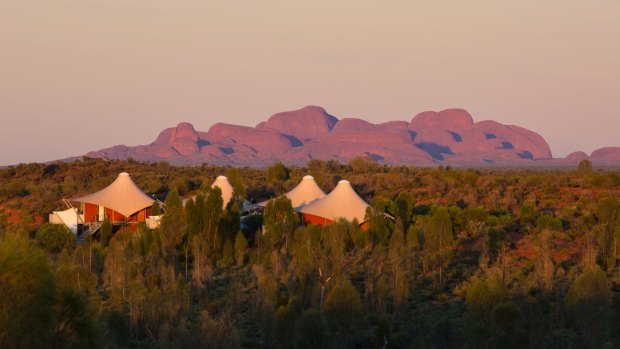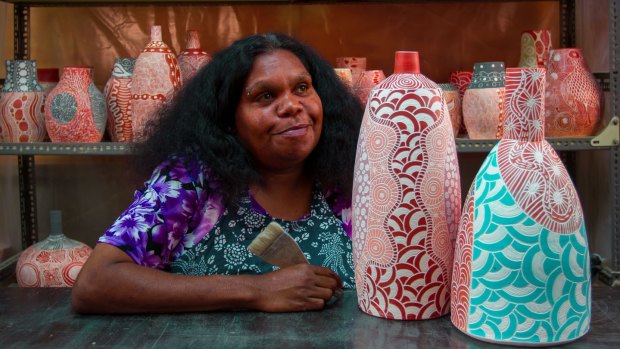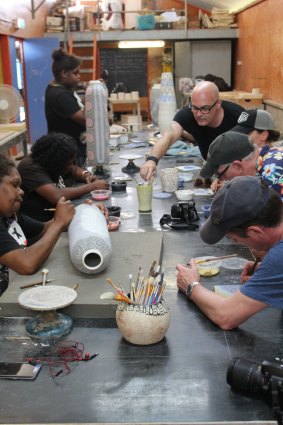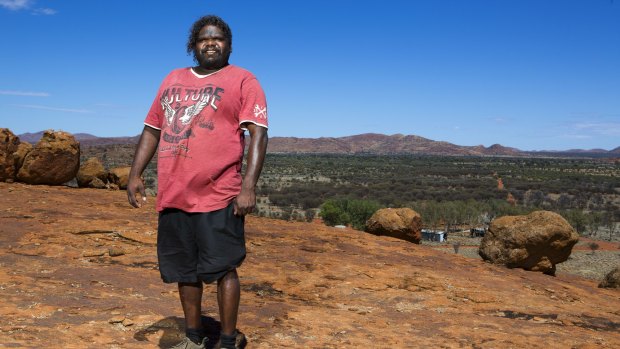By Keith Austin

Longitude 131 is not your average tented accommodation.
There is a certain ceramic pot in the corner of the lounge at the stupidly pulchritudinous Longitude 131 resort that does its best to take the eye away from the equally comely, uninterrupted view of Uluru through the room's floor-to-ceiling windows.
Standing 1.8 metres tall, this elegant, intricate artwork – "pot" really is too insulting a word for it – is the result of an unusual collaboration between the Ernabella community of Indigenous artists just across the border in South Australia and a town south-west of Shanghai known as the Porcelain Capital of China.
The pot is the work of Tjimpuna Williams, one of two ceramicists from Ernabella who in 2015 went to Jingdezhen in China's Jiangxi Province for an artist's residency. Williams and Derek Jungarrayi Thompson travelled to the wonderfully and accurately named Big Pot Factory thanks to commissions from James and Hayley Baillie, the newish owners of Longitude 131.

Tjimpuna Williams.
During their time in Jingdezhen, which has a history of porcelain-making going back 1700 years, Williams and Thompson created more than 40 large pots – including the one that now has pride of place in Longitude 131's Dune House.
Ernabella Arts was established in 1948, making it the oldest continuously running Indigenous arts centre in Australia. Guests at Longitude 131 will find plenty of the centre's smaller work for sale at the resort but what could be better than to journey into the vast red heart of Australia to see it being made by the artists themselves?
The Ernabella day trip is part of plans by the Baillies to encourage longer stays that include not only the usual Uluru experiences but also the opportunity to delve deeper into Central Australia's Indigenous culture.

The workshop: Getting down to business with the artists at Ernabella Arts.
Ernabella is pretty much as out back as you can get. Tucked into the folds of the Musgrove Ranges in the remote Pukatja homelands – one of 13 communities that make up the Anangu Pitjantjatjara Yankunytjatjara (APY) lands – it's an hour from Uluru even by helicopter. Driving takes you on to the red earth roads that lead into open spaces so vast they beggar belief.
Here, the sky is like the inside of a gigantic snow dome. Here, occasional road trains tear along arrow-straight roads and trail clouds of ochre dust as if they're on fire. This is where the cattle stations are bigger than some countries and the desert is dotted with the squat hulks of abandoned cars ("desert gnomes" as they are called) ) rusting into rust-coloured dirt.
You'll also pass Mount Conner, the great lump of rock often mistaken for its not-so-distant cousin Uluru by people coming from South Australia and, as a consequence, known as Fooluru.

Derek Jungarrayi Thompson.
We are lucky enough to helicopter in and drive out – an arrangement which combines the best of both worlds. There can be no better sensation than lifting off from Longitude 131 and heading south with Uluru to the right and your shadow chasing across the desert below.
It is from up here that you also begin to have a greater appreciation of the significance of Aboriginal dot paintings as the unusually green landscape reveals the bird's-eye view of spinifex circles, mulga trees and the pale green polka dots of fallen leaves around the base of hardy desert oaks.
Ernabella Arts began life as a simple craft room making floor rugs for the local cattle stations but has evolved to become a critically acclaimed art centre whose works are sought all over the world. Today it's housed in a simple but colourful building which used to be the mission kitchen and is where artists work at intricate dot paintings and beautiful ceramics depicting Indigenous symbols and tjukurpa (sacred stories of country and law). Certainly, if you want a vase or pot decorated with honey ants or a snake this is the place to come.
Not that you can just walk in off the street because Ernabella is a closed community and you need permission to enter – an arrangement now available to Longitude 131 guests as part of the one-day trip to meet the artists.
We are met by Pepai Jangala Carroll, an elder and a painter and ceramicist in his own right, who takes us on a tour of the centre where men and women sit patiently and expertly applying colourful dots to canvases large and small.
In the ceramics area at the rear of the building we come across Derek Jungarrayi Thompson and several other artists working on freshly made vases and pots. In the far corner an open kiln full of just-fired vessels sits radiating heat (12 hours to fire up and 12 hours to cool down) into the already steamy room. Shelves along one wall are lined with pots, still pale pastel imitations of the vibrant objects they will become after their baptism of fire.
But it's one thing to watch Thompson, brown hat pulled low, carving his story, his country, into the soft clay of a pot (amazingly, he works from his imagination straight on to the surface) and quite another to do it yourself.
But that's just what they make you do. Four simple square tiles are produced and we sit down to paint and then carve our works of art. It's not as simple as it looks – and that blank tile is viciously unhelpful.
In the end, urged by one of the artists to "paint your country, paint your story", I produce a snake falling through the night sky on to the battlements of a fairytale castle or, depending on your imagination, an eel swimming in the Thames past the Tower of London.
What it does is bring into frighteningly sharp focus what these artists manage to do with their intricate designs of honey ants or lizards or representations of country – the skill, the hand-eye co-ordination and the imagination that bring the pots to life is shockingly clear.
And so while Derek Jungarrayi Thompson quietly produces a masterpiece up one end of the table, we all end up with tiles that look like they were made by slightly dim primary school children. You can just imagine the teacher saying "Yes, yes, lovely dear; I'm sure your mum will love it."
I hope so, because mine's getting it for Christmas. Well, nobody else will take it, that's for sure.
TRIP NOTES
MORE INFORMATION
GETTING THERE
Only three hours by air from the east coast of Australia, regular flights are available to Ayers Rock Airport with Australia's major domestic airlines. Virgin Australia operates daily direct flights to Ayers Rock Airport from Sydney, Jetstar also flies direct on select days, while Qantas operates daily flights via Alice Springs. Longitude 131 provides complimentary guest transfers to connect with all Ayers Rock Airport flights.
SEE + DO
The Ernabella day trip from Longitude 131 costs $1000 a person in a luxury four-wheel-drive and operates seasonally. The round trip involves seven hours driving; scenic aircraft transfers are available for an additional cost. See ernabellaarts.com.au and blog.baillielodges.com.au/longitude-131-connects-with-ernabella-arts.
Bruce Munro's Field of Light installation is at Uluru until March 31, 2017.
Keith Austin was a guest of Longitude 131.
Sign up for the Traveller Deals newsletter
Get exclusive travel deals delivered straight to your inbox. Sign up now.